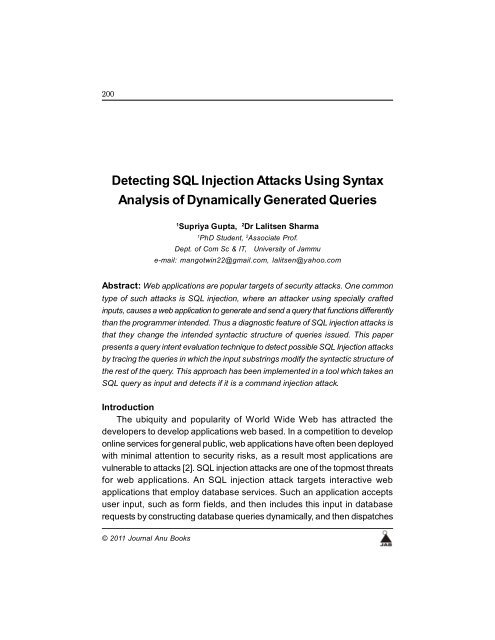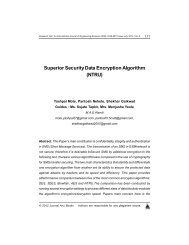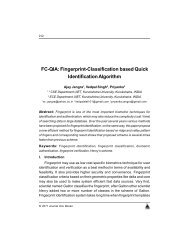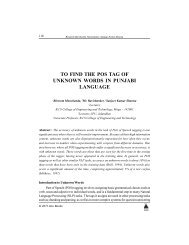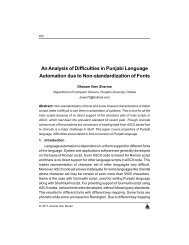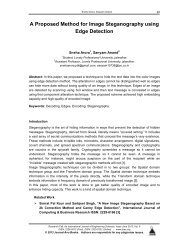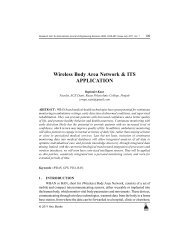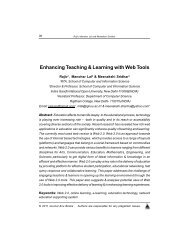Detecting SQL Injection Attacks Using Syntax Analysis of ...
Detecting SQL Injection Attacks Using Syntax Analysis of ...
Detecting SQL Injection Attacks Using Syntax Analysis of ...
Create successful ePaper yourself
Turn your PDF publications into a flip-book with our unique Google optimized e-Paper software.
200<br />
<strong>Detecting</strong> <strong>SQL</strong> <strong>Injection</strong> <strong>Attacks</strong> <strong>Using</strong> <strong>Syntax</strong><br />
<strong>Analysis</strong> <strong>of</strong> Dynamically Generated Queries<br />
1<br />
Supriya Gupta, 2 Dr Lalitsen Sharma<br />
1<br />
PhD Student, 2 Associate Pr<strong>of</strong>.<br />
Dept. <strong>of</strong> Com Sc & IT, University <strong>of</strong> Jammu<br />
e-mail: mangotwin22@gmail.com, lalitsen@yahoo.com<br />
Abstract: Web applications are popular targets <strong>of</strong> security attacks. One common<br />
type <strong>of</strong> such attacks is <strong>SQL</strong> injection, where an attacker using specially crafted<br />
inputs, causes a web application to generate and send a query that functions differently<br />
than the programmer intended. Thus a diagnostic feature <strong>of</strong> <strong>SQL</strong> injection attacks is<br />
that they change the intended syntactic structure <strong>of</strong> queries issued. This paper<br />
presents a query intent evaluation technique to detect possible <strong>SQL</strong> <strong>Injection</strong> attacks<br />
by tracing the queries in which the input substrings modify the syntactic structure <strong>of</strong><br />
the rest <strong>of</strong> the query. This approach has been implemented in a tool which takes an<br />
<strong>SQL</strong> query as input and detects if it is a command injection attack.<br />
Introduction<br />
The ubiquity and popularity <strong>of</strong> World Wide Web has attracted the<br />
developers to develop applications web based. In a competition to develop<br />
online services for general public, web applications have <strong>of</strong>ten been deployed<br />
with minimal attention to security risks, as a result most applications are<br />
vulnerable to attacks [2]. <strong>SQL</strong> injection attacks are one <strong>of</strong> the topmost threats<br />
for web applications. An <strong>SQL</strong> injection attack targets interactive web<br />
applications that employ database services. Such an application accepts<br />
user input, such as form fields, and then includes this input in database<br />
requests by constructing database queries dynamically, and then dispatches<br />
© 2011 Journal Anu Books
Research Cell: An International Journal <strong>of</strong> Engineering Sciences ISSN: 2229-6913 Issue Sept 2011, Vol. 4<br />
201<br />
these queries over an API to appropriate databases for execution. In such a<br />
way, a web application retrieves and presents data to the user based on the<br />
user’s input as part <strong>of</strong> the application’s functionality. However, if the user’s<br />
input is not handled properly, serious security problems can occur. This is<br />
because queries are constructed dynamically in an ad hoc manner through<br />
low-level string manipulations. This is ad hoc because databases interpret<br />
query strings as structured, meaningful commands, while web applications<br />
<strong>of</strong>ten view query strings simply as unstructured sequences <strong>of</strong> characters.<br />
This semantic gap, combined with improper handling <strong>of</strong> user input, makes<br />
web applications susceptible to a large class <strong>of</strong> malicious attacks known as<br />
<strong>SQL</strong> command injection attacks (<strong>SQL</strong>CIA).<br />
For example, if a database contains user names and passwords, the<br />
application may contain code such as the following:<br />
String query = “SELECT * FROM accounts WHERE<br />
name=’” + request.getParameter(“name”) + “‘ AND<br />
password=’” + request.getParameter(“passwd”) + “‘“;<br />
Figure 1<br />
The code in Figure 1 generates a query intended to be used to authenticate<br />
a user who tries to login to a web site. However, if a malicious user enters<br />
admin into the name field and ‘OR’ a’=’a. into the password field, the query<br />
string generated is shown in figure 2, whose condition always evaluates to<br />
true, and the user will bypass the authentication logic.<br />
SELECT * FROM accounts WHERE name=’admin’<br />
AND password= ‘’ OR ‘a’=’a’<br />
Figure 2<br />
<strong>SQL</strong> injection attacks are extremely prevalent, and ranked as the second<br />
most common form <strong>of</strong> attack on web applications in 2010 [1]. The percentage<br />
<strong>of</strong> these attacks among the overall number <strong>of</strong> attacks reported rose from<br />
5.5% in 2004 to 14% in 2006 to 24% in 2008[4]. Out <strong>of</strong> various vulnerabilities<br />
reported in 2010, <strong>SQL</strong> injection vulnerabilities amount significantly with 18%<br />
© 2011 Journal Anu Books
202<br />
Supriya Gupta, Dr Lalitsen Sharma<br />
and they continued to make up the largest percentage <strong>of</strong> the reported<br />
vulnerabilities [1]. The <strong>SQL</strong>CIA on Card Systems Solutions Inc. [3] that<br />
exposed several hundreds <strong>of</strong> thousands <strong>of</strong> credit card numbers is an<br />
example <strong>of</strong> how such attack can victimize an organization and members <strong>of</strong><br />
the general public.<br />
Related Work<br />
Research on <strong>SQL</strong> injection attacks can be broadly classified into two<br />
basic categories: 1) vulnerability identification approaches and 2) attack<br />
prevention approaches. The former category consists <strong>of</strong> techniques that<br />
identify vulnerable locations in a web application that may lead to <strong>SQL</strong><br />
injection attacks. In order to avoid <strong>SQL</strong> injection attacks, most <strong>of</strong> these<br />
protections rely on traditional signature detection techniques which inspect<br />
web traffic to identify <strong>SQL</strong> injection-related text patterns. A reasonably sized<br />
signature database does not provide reliable protection while a<br />
comprehensive signature database results in excessive management<br />
overhead, dramatic performance limitations, and false positives [6, 7]. The<br />
static analysis techniques for vulnerability identification presented in [8, 9,<br />
15, 16] are based on tainted information flow tracking. They require manually<br />
written specifications, either for each query or for bug patterns and they are<br />
not fully automated and may require user intervention at various points in<br />
the analysis. They do not provide any way to check the correctness <strong>of</strong> the<br />
input validation routines, and programs using incomplete input validation<br />
routines may indeed pass these checks and still be vulnerable to injection<br />
attacks.<br />
A much more satisfactory treatment <strong>of</strong> the problem is provided by the<br />
class <strong>of</strong> attack prevention techniques that retr<strong>of</strong>it programs to shield<br />
themselves against <strong>SQL</strong> injection attacks [10, 11, 12, 13,]. In order to avoid<br />
<strong>SQL</strong> injection attacks, a programmer <strong>of</strong>ten subjects all inputs to input<br />
validation and filtering routines that either detects attempts to inject <strong>SQL</strong><br />
commands or sans the input. Relying on input validation routines as the<br />
sole mechanism for <strong>SQL</strong> injection defense is problematic. Although they<br />
can serve as a first level <strong>of</strong> defense, it is widely agreed [13] that they cannot<br />
defend against sophisticated attack techniques. For example, if an application<br />
© 2011 Journal Anu Books
Research Cell: An International Journal <strong>of</strong> Engineering Sciences ISSN: 2229-6913 Issue Sept 2011, Vol. 4<br />
203<br />
forbids the use <strong>of</strong> the single-quote in input, <strong>SQL</strong>CIAs may still be possible<br />
because numeric literals are not delimited with quotes. The problem is that<br />
web applications generally treat input strings as isolated lexical entities. Input<br />
strings and constant strings are combined to produce structured output<br />
(<strong>SQL</strong> queries) without regard to the structure <strong>of</strong> the output language (<strong>SQL</strong>).<br />
A more fundamental technique to the problem <strong>of</strong> defending <strong>SQL</strong> injection<br />
comes from the commercial database world, in the form <strong>of</strong> PREPARE<br />
statements [14]. These statements allow a programmer to declare and<br />
finalize the structure <strong>of</strong> every <strong>SQL</strong> query in the application. Once issued,<br />
these statements do not allow malformed inputs to further influence the<br />
<strong>SQL</strong> query structure, thereby avoiding <strong>SQL</strong> vulnerabilities altogether. This is<br />
in fact a robust mechanism to prevent <strong>SQL</strong> injection attacks; however, if<br />
other portions <strong>of</strong> the query are being built up with unescaped input, <strong>SQL</strong><br />
injection is still possible. Also retr<strong>of</strong>itting an application to make use <strong>of</strong><br />
PREPARE statements requires manual effort in specifying the intended query<br />
at every query point, and the effort required is proportional to the complexity<br />
<strong>of</strong> the web application.<br />
Overview <strong>of</strong> the Approach<br />
In this paper the problem is approached by tracking through the program<br />
the substrings from user input and restricting those substrings syntactically.<br />
A web application generates a query by combining filtered inputs and constant<br />
strings [15].<br />
String query = “SELECT * FROM accounts WHERE<br />
name=’” + sanitizedName + “‘ AND password=’” +<br />
paswd + “‘“;<br />
Figure 3<br />
For example in figure 3, “sanitizedName” is a filtered input, and “SELECT<br />
* FROM accounts” is a constant string for building dynamic queries. If the<br />
user inputs admin as his user name and password into the password field,<br />
the query string generated is shown in figure 4.<br />
© 2011 Journal Anu Books
204<br />
Supriya Gupta, Dr Lalitsen Sharma<br />
String query = “SELECT * FROM accounts WHERE<br />
name= ‘admin’ AND password= ‘ password ‘“;<br />
Figure 4<br />
Figure 5a: Parse tree for where clause <strong>of</strong> query in figure 4. Sub strings from user input are<br />
underlined<br />
A malicious user may replace the password in the input with ’OR’ a’= ‘a<br />
in order to bypass the authentication logic, the generated query is represented<br />
in figure 2. Figure 5 shows a parse tree for each query. For demonstration<br />
purpose, consider the simplified grammar for <strong>SQL</strong> SELECT statement’s<br />
where_clause in Figure 7(a). This is the grammar used to generate the<br />
parse trees in Figure 5. Note that in Figure 5a, for each substring from input<br />
there exists a node in the parse tree whose descendant leaves comprise<br />
the entire input substring and no more: general_lit the first substring and<br />
general_lit for the second, as shown with underline.<br />
© 2011 Journal Anu Books
Research Cell: An International Journal <strong>of</strong> Engineering Sciences ISSN: 2229-6913 Issue Sept 2011, Vol. 4<br />
205<br />
Figure 5b: Parse tree for where clause <strong>of</strong> query in figure 2. Sub strings from user input are<br />
underlined<br />
No such parse tree node exists for the second input substring in Figure<br />
5b. This distinction is common to all examples <strong>of</strong> legitimate vs. malicious<br />
queries that we have seen. The intuition behind this distinction is that the<br />
malicious user attempts to cause the execution <strong>of</strong> a query beyond the<br />
constraints intended by the programmer, while the normal user does not<br />
attempt to break any such constraints. This distinction is used to identify<br />
queries in which the input substrings change the syntactic structure <strong>of</strong> the<br />
rest <strong>of</strong> the query. Such queries are command injection attack. To track user’s<br />
input we use meta-data, displayed as ‘&’ and ‘&,’ to mark the beginning and<br />
end <strong>of</strong> each input string so that when a query is ready to be sent to the<br />
database, it has matching pairs <strong>of</strong> markers identifying the substrings from<br />
input. This annotated query is called an augmented query. Figure 6 shows<br />
© 2011 Journal Anu Books
206<br />
Supriya Gupta, Dr Lalitsen Sharma<br />
instance <strong>of</strong> augmented query for the queries generated in figure 4 and figure<br />
2 respectively.<br />
SELECT * FROM accounts WHERE name=& ‘admin’&<br />
AND password=& ‘ password’&<br />
SELECT * FROM accounts WHERE name= &’admin’&<br />
AND password= &’’ OR ‘a’=’a’&<br />
Figure 6: augmented queries<br />
In order to forbid input substrings from modifying the syntactic structure<br />
<strong>of</strong> the rest <strong>of</strong> the query we construct an augmented grammar for augmented<br />
queries based on the standard grammar for <strong>SQL</strong> queries [17]. The algorithm<br />
for constructing augmented grammar is presented in [19].In the augmented<br />
grammar, the only productions in which ‘&’ occur have the following form:<br />
nonterm ::= &symbol &, where symbol is either a terminal or a non-terminal.<br />
where_clause ::= “where” search_condition<br />
search_condition ::= boolean_value_exp<br />
boolean_value_exp ::= { boolean_term, boolean_term_op } ;<br />
boolean_term_op ::= “or” ;<br />
boolean_term ::= { boolean_factor, boolean_factor_op } ;<br />
boolean_factor_op ::= “and”<br />
boolean_factor ::= { val_exp , comp_op }<br />
val_exp ::=<br />
unsigned_lit|id<br />
unsigned_lit ::= unsigned_num_lit |’ general_lit’ ;<br />
id ::= [“_” char_set_spec] actual_id ;<br />
actual_id ::= identifier ;<br />
comp_op ::= = | < | > | = | !=<br />
Figure 7a:Simplified grammar for where clause<br />
© 2011 Journal Anu Books
Research Cell: An International Journal <strong>of</strong> Engineering Sciences ISSN: 2229-6913 Issue Sept 2011, Vol. 4<br />
207<br />
where_clause ::=<br />
“where” search_condition<br />
search_condition ::= boolean_value_exp<br />
boolean_value_exp ::= { boolean_term, boolean_term_op } ;<br />
boolean_term_op ::= “or” ;<br />
boolean_term ::= { boolean_factor, boolean_factor_op } ;<br />
boolean_factor_op ::= “and”<br />
boolean_factor ::= { val_exp , comp_op }<br />
val_exp ::=<br />
unsigned_lita | id<br />
unsigned_lita ::=<br />
unsigned_lit| “&” unsigned_lit “&”;<br />
unsigned_lit ::= unsigned_num_lit | ‘general_lit’ ;<br />
id ::= [“_” char_set_spec] actual_id |<br />
actual_ida ;<br />
actual_ida ::= “&” actual_id “&” ;<br />
actual_id ::=<br />
identifier<br />
comp_op::= = | < | > | = | !=<br />
Figure 7b:Simplified augmented grammar for where clause<br />
For an augmented query to be in the language <strong>of</strong> this grammar, the<br />
substrings surrounded by ‘&’ must be syntactically confined. Figure 7 shows<br />
the simplified grammar for the where_clause and the corresponding<br />
augmented grammar (Figure 7b).<br />
Now consider the augmented queries shown in Figure 6.<strong>Using</strong> the<br />
augmented grammar, the parse tree for the first query would look the same<br />
as Figure 5a, except that the sub trees shown in Figures 8 would be<br />
substituted in for the first and second input strings, respectively. No parse<br />
tree could be constructed for the second augmented query.<br />
© 2011 Journal Anu Books
208<br />
Supriya Gupta, Dr Lalitsen Sharma<br />
Figure 8<br />
Therefore to prevent invalid queries augment the query and then attempt<br />
to parse the augmented query with the augmented grammar. If the query<br />
fails to parse it is invalid.<br />
We use a parser generator ProGrammar [18] to build a parser for the<br />
augmented grammar and attempt to parse each augmented query. If the<br />
query parses successfully, it meets the syntactic constraints and is<br />
legitimate. Otherwise, it fails the syntactic constraints and either is a<br />
command injection attack or is meaningless to the interpreter that would<br />
receive it. A tool called <strong>SQL</strong> <strong>Injection</strong> Detector is written in visual basic 6.0<br />
using the augmented grammar <strong>of</strong> the <strong>SQL</strong> language and a policy specifying<br />
permitted syntactic forms. Each input that is to be propagated into some<br />
query, regardless <strong>of</strong> the input’s source, is augmented with the meta-character<br />
‘&’ and generated augmented query, is inputted which our tool attempts to<br />
parse. If a query parses successfully, the query is safe and otherwise it is<br />
an <strong>SQL</strong> command injection attack. Figure 8 shows the result obtained by<br />
<strong>SQL</strong> <strong>Injection</strong> Detection tool for the second augmented query in figure 4.<br />
The tool is tested with different forms <strong>of</strong> injection attacks and is successful<br />
in detecting <strong>SQL</strong>CIAs with 0 false positives.<br />
© 2011 Journal Anu Books
Research Cell: An International Journal <strong>of</strong> Engineering Sciences ISSN: 2229-6913 Issue Sept 2011, Vol. 4<br />
209<br />
Figure 8: Screenshot <strong>SQL</strong> <strong>Injection</strong> Detector tool.<br />
Acknowledgment<br />
The authors are thankful to University Grants Commission (UGC), and<br />
Ministry <strong>of</strong> Human Resource Development (MHRD), Government <strong>of</strong> India<br />
for providing financial assistance to carry out this research work. The authors<br />
are also thankful to Pr<strong>of</strong>. Devanand, Head, Department <strong>of</strong> Computer Science<br />
and IT, University <strong>of</strong> Jammu, for his kind support.<br />
References<br />
1. Cenzic Web Application Security Trends Report – Q3-Q4, 2010, Cenzic Inc.<br />
Retriev ed on on 9-8-2011 f rom http://www.cenzic.com/<br />
Cenzic_AppSecTrends_Q3-Q4-2010.pdf.<br />
2. Pettit S. (2001). Anatomy <strong>of</strong> a Web Application: Security Considerations.<br />
Sanctum, Inc.<br />
3. Kerk J. (2006). <strong>SQL</strong> injection attacks against databases rise sharply: Legal<br />
issues. Retrieved on 9-8-2011 from http://www.computerworld.com/s/article/<br />
9001878/ <strong>SQL</strong>_injection_attacks_against_databases_rise_sharply<br />
4. Cenzic Web Application Security Trends Report – Q3-Q4, 2008, Cenzic Inc.<br />
Retrieved on 9-4-2011 from http://www.cenzic.com/Cenzic_AppSecTrends_Q3-<br />
Q4-2008.pdf.<br />
5. Anley, C (2002). Advanced <strong>SQL</strong> injection in <strong>SQL</strong> server applications, White<br />
paper, Next Generation Security S<strong>of</strong>tware Ltd. Tech. rep.<br />
© 2011 Journal Anu Books
210<br />
Supriya Gupta, Dr Lalitsen Sharma<br />
6. O. Maor and A. Shulman (2002). <strong>SQL</strong> injection signatures evasion. White<br />
paper, Imperva. Tech. rep.<br />
7. Xie, Y., and Aiken (2006), A. Static detection <strong>of</strong> security vulnerabilities in scripting<br />
languages. In USENIX Security Symposium.<br />
8. Livshits, V. B., and Lam, M. S (2005). Finding security vulnerabilities in Java<br />
applications with static analysis. In USENIX Security Symposium.<br />
9. Halfond, W., and Orso, A (2005). AMNESIA: <strong>Analysis</strong> and Monitoring for<br />
NEutralizing <strong>SQL</strong>-<strong>Injection</strong> <strong>Attacks</strong>. In the Proceedings <strong>of</strong> the 20th IEEE/ACM<br />
international Conference on Automated s<strong>of</strong>tware engineering ( ASE 05), pp.<br />
174–183.<br />
10. Valeur, F., Mutz, D., and Vigna, G (2005). A learning-based approach to the<br />
detection <strong>of</strong> sql attacks. In the Proceedings <strong>of</strong> the Conference on Detection <strong>of</strong><br />
Intrusions and Malware & Vulnerability Assessment (DIMVA), Vienna, Austria,<br />
pp. 123–140.<br />
11. Nguyen-Tuong A.,Guarnieri S., Greene D., Shirley J. & D. Evans (2005).<br />
Automatically hardening web applications using precise tainting. 20th IFIP<br />
International Information Security Conference ,pp. 295–308.<br />
12. Pietraszek, T., and Berghe, C. V (2005). Defending against injection attacks<br />
through context-sensitive string evaluation. In the Proceedings <strong>of</strong> the 8th<br />
International Symposium on Recent Advances in Intrusion Detection (RAID).<br />
13. Buehrer, G., Weide, B. W., and Sivilotti, G (2005). <strong>Using</strong> parse tree validation<br />
to prevent sql injection attacks. In Proceedings <strong>of</strong> the 5th international workshop<br />
on S<strong>of</strong>tware engineering and middleware (SEM 05).<br />
14. Prepared statements and stored procedures, Retrieved on 9-8-2011 from http:/<br />
/php. net /manual/en/pdo .prepared -statements.php<br />
15. Wassermann G., Su Z (2007). Sound and Precise <strong>Analysis</strong> <strong>of</strong> Web Applications<br />
for <strong>Injection</strong> Vulnerabilities. Proceedings <strong>of</strong> the 2007 ACM SIGPLAN conference<br />
on Programming language design and implementation (PLDI’07).<br />
16. Wassermann G., Su Z. (2004, May). An <strong>Analysis</strong> Framework for Security in<br />
Web Applications. Department <strong>of</strong> Computer Science, University <strong>of</strong> California.<br />
© 2011 Journal Anu Books
Research Cell: An International Journal <strong>of</strong> Engineering Sciences ISSN: 2229-6913 Issue Sept 2011, Vol. 4<br />
211<br />
Specification and Verification <strong>of</strong> Component Based Systems Workshop at<br />
ACM SIGSOFT 2004 (SAVCBS’04).<br />
17. BNF Grammars for <strong>SQL</strong>-92, <strong>SQL</strong>-99 and <strong>SQL</strong>-2003, Retrieved on 9-8-2011<br />
from http://savage.net.au/<strong>SQL</strong>/<br />
18. ProGrammar, Parser Development Toolkit. http://www.programmar.com/<br />
19. Wassermann G., Su Z. (2006). The essence <strong>of</strong> command injection attacks in<br />
web applications. In the Proceedings <strong>of</strong> the 2006 POPL Conference.<br />
© 2011 Journal Anu Books


